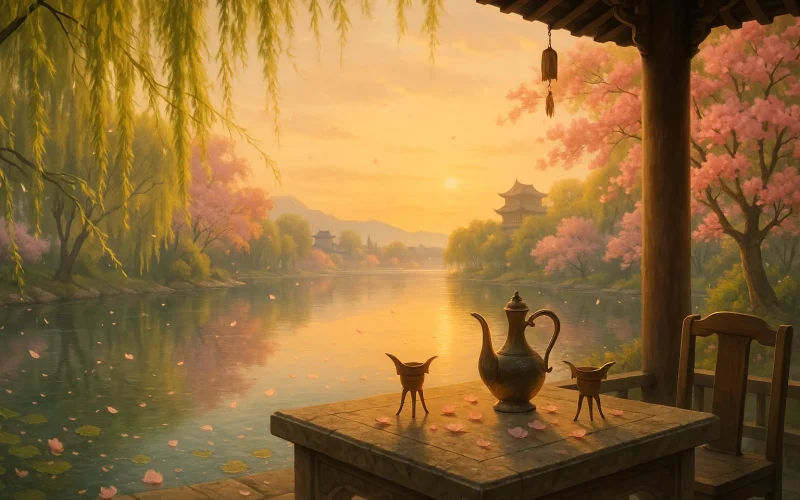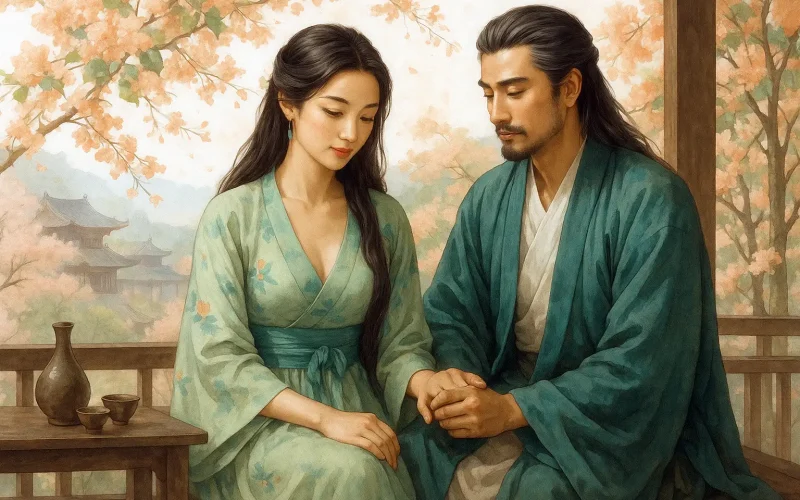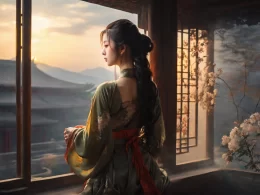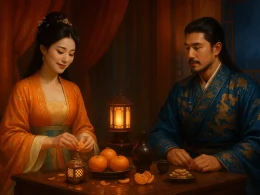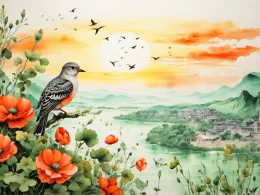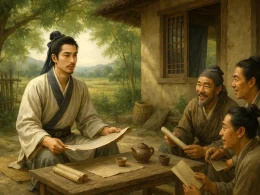With winecup in hand, I hail the east wind:
"Stay awhile, let us take life easy!"
By purple paths of Luoyang's eastern town,
Where willow branches hang low—
Every spot here is where we once strolled hand in hand,
Through fragrant blooms without end.
Meeting and parting—so bitter, so rushed!
This regret has no bounds.
This year's flowers outshine last year's red;
Next year's blossoms will be fairer still—
But with whom shall I share their sight?
Original Poem
「浪淘沙 · 把酒祝东风」
把酒祝东风,且共从容。
垂杨紫陌洛城东。
总是当时携手处,游遍芳丛。聚散苦匆匆,此恨无穷。
欧阳修
今年花胜去年红。
可惜明年花更好,知与谁同?
Interpretation
Composed in the spring of 1032 AD (the first year of Emperor Renzong's Mingdao era), this ci poem was written during Ouyang Xiu's tenure in Luoyang. It depicts a spring reunion with a dear friend (likely Mei Yaochen) amidst familiar blossoms, where radiant scenery serves as a vessel for lamenting life's impermanent meetings and fleeting youth. The work exemplifies Ouyang's signature lyrical style—delicate yet profound, restrained yet deeply moving.
First Stanza: "把酒祝东风,且共从容。垂杨紫陌洛城东。总是当时携手处,游遍芳丛。"
Bǎ jiǔ zhù dōng fēng, qiě gòng cóng róng. Chuí yáng zǐ mò luò chéng dōng. Zǒng shì dāng shí xié shǒu chù, yóu biàn fāng cóng.
Toasting the east wind with wine,
"Linger with us," I implore.
Willows sweep purple paths we tread before—
All lanes where once hand-in-hand we'd roam,
Through every bloom-strewn corridor.
The stanza opens with an allusion to Sikong Tu's famous line (把酒祝东风), transforming the wind into a convivial guest. "Linger with us" (共从容) carries dual resonance—both an entreaty to prolong the spring day and a celebration of shared presence. The tactile memory of "hand-in-hand" (携手处) superimposed on present willows (垂杨) creates layered temporality, where physical paths become emotional palimpsests.
Second Stanza: "聚散苦匆匆,此恨无穷。今年花胜去年红。可惜明年花更好,知与谁同?"
Jù sàn kǔ cōng cōng, cǐ hèn wú qióng. Jīn nián huā shèng qù nián hóng. Kě xī míng nián huā gèng hǎo, zhī yǔ shuí tóng?
Meetings part too soon—this grief
Endures beyond all measure.
This year's blooms outblush last year's fire—
Yet crueler still when next spring's flowers
Burn brighter…for whose eyes? Whose hand to admire?
The lament transitions from spatial to temporal dimensions. Floral superlatives ("outblush"/"burn brighter") underscore life's cruel irony: nature's cyclical perfection contrasts with human relationships' linear fragility. The unanswered question (知与谁同) hangs like a petal in air, its grammatical suspension mirroring the speaker's unresolved longing. The stanza's mathematical progression (last year/this year/next year) quantifies ephemerality with heartbreaking precision.
Holistic Appreciation
This is a lyric poem blending spring's passing with farewell sorrow, where scenery dissolves into emotion, creating an enduring artistic conception. The upper stanza begins with revisiting spring outings of yore, recalling shared flower-viewing experiences to evoke profound friendship and present appreciation of spring's beauty. The lower stanza naturally transitions to lyrical expression, progressing from life's "swift reunions and partings" to the poignant melancholy of "flowers more splendid" yet "with whom to share." The structure is compact yet dynamic, with seamless integration of scene and sentiment, displaying an elegant subtlety rarely seen in Ouyang Xiu's typically vigorous style.
The most remarkable feature lies in the masterful deployment of floral imagery. Flowers in full bloom mirror genuine affection; their enhanced splendor intensifies parting grief. The concluding line "with whom to share" breaks off abruptly yet resonates endlessly, like the lingering vibration of a snapped string.
Artistic Merits
- Returning to Old Haunts, Blending Scene and Emotion: The poet's revisit to familiar grounds stirs emotional waves, using spring's glory to express friendship's weight, achieving organic fusion of setting and feeling that moves profoundly.
- Temporal Layering, Exquisite Composition: Structured around "last year, this year, next year," it forms a temporal progression of memory-present-future, allowing thematic development and emotional deepening.
- Sparse Imagery, Lucid Diction: Spring motifs like "weeping willows," "purple paths" and "fragrant groves" unfold naturally. "Toasting the east wind with wine" blends cultural allusion with genuine sentiment in refined yet unadorned language.
- Philosophy in Emotion, Sorrow Without Despair: Though a farewell poem, it avoids excessive melancholy, instead observing life's impermanence through floral cycles, embedding philosophical contemplation with enduring resonance.
Insights
This lyric reveals life's inevitable impermanence of meetings and partings. Precisely because reunions are rare, we should cherish present companionship. Through flower-viewing and revisiting old sites, the poet expresses tender remembrance and parting sorrow with authentic yet restrained emotion. It conveys not only time-induced nostalgia between people, but also inspires pursuit of genuine warmth within life's limits. Flowers bloom yearly, but kindred spirits may not. As the poem laments: "Next year's fairer flowers—but with whom to share?" This line crystallizes the philosophy of life's transient connections.
About the Poet
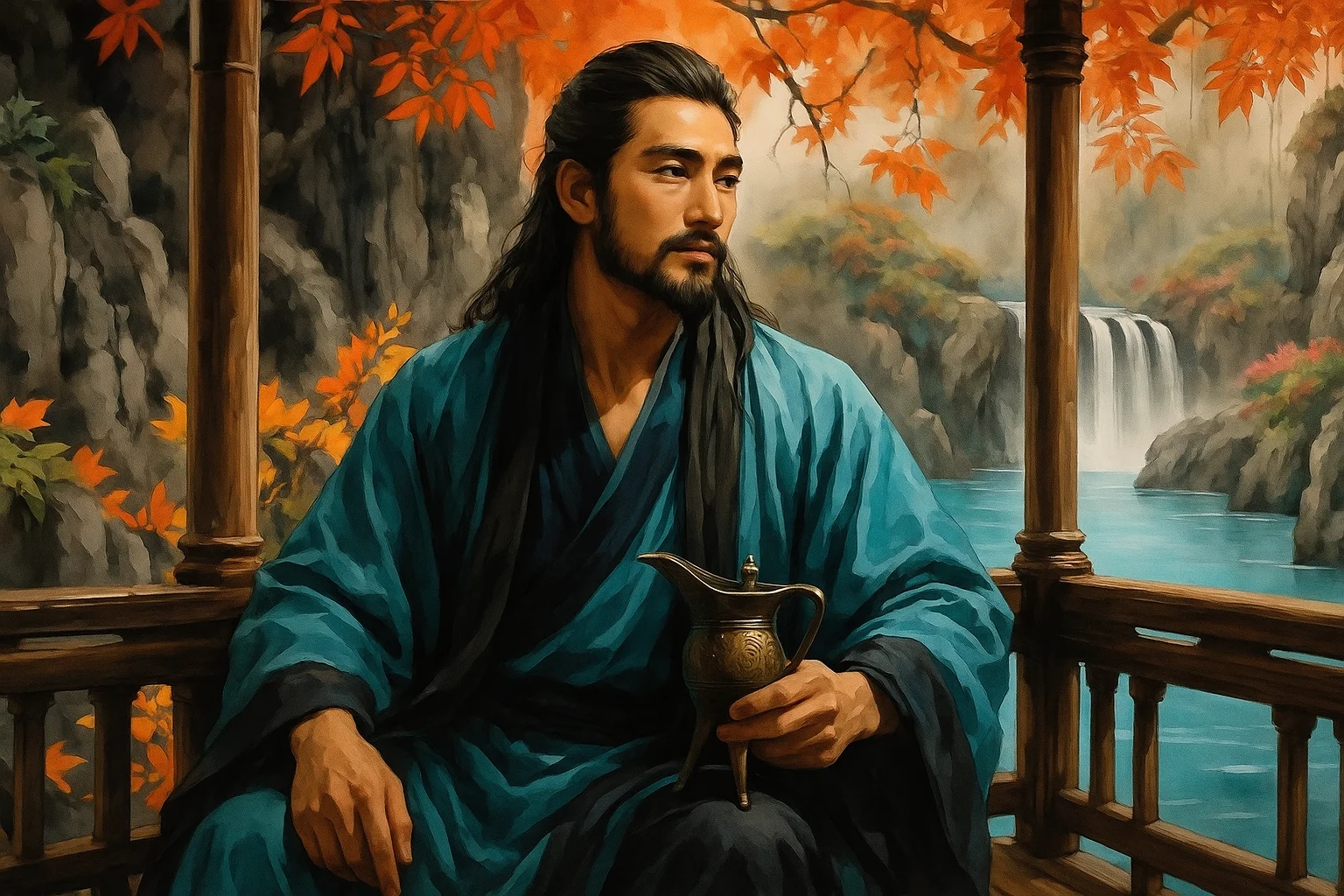
Ouyang Xiu (欧阳修, 1007 - 1072), a native of Yongfeng, Jizhou (present-day Jiangxi Province), emerged as the preeminent literary figure of the Northern Song Dynasty. After attaining the jinshi degree in 1030, he spearheaded a literary reform movement that rejected the ornate Xikun style prevalent at court. As a mentor who nurtured literary giants like Su Shi and Zeng Gong, he laid the foundation for the golden age of Northern Song literature. Recognized as one of the "Eight Great Prose Masters of Tang and Song," Ouyang stands as the pivotal figure in the transformation of Northern Song literary culture.






